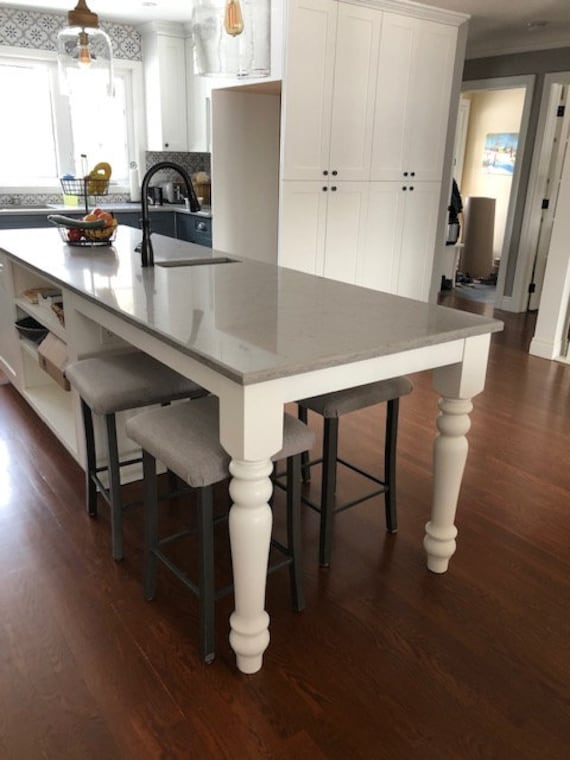Include Security and Elegance with Sturdy Legs For Kitchen Island Installments
Include Security and Elegance with Sturdy Legs For Kitchen Island Installments
Blog Article
Crucial Factors to Consider When Choosing Legs For Kitchen Area Island
Choosing the appropriate legs for a cooking area island entails a mindful evaluation of multiple variables that can significantly affect both performance and visual charm. As we check out these aspects, it becomes clear that each decision can have far-ranging implications for the general kitchen area experience.
Material Options
When selecting legs for a kitchen area island, understanding the various product options is important for accomplishing both aesthetic appeal and architectural stability (Legs For Kitchen Island). The option of product considerably affects not just the resilience of the island however likewise its general style and functionality
Metal legs, typically made from stainless steel or wrought iron, add a commercial and modern-day feel while ensuring sturdiness and stability. These products are immune to put on and can support significant weight, making them excellent for bigger islands.
An additional choice is crafted materials, like MDF or plywood, which can be much more cost-efficient while still supplying a series of surfaces. Nevertheless, they might not supply the very same degree of security as strong wood or metal. Finally, products such as acrylic or glass can develop a modern appearance, though they might need extra support to guarantee security.
Eventually, the option of product for kitchen island legs ought to straighten with the desired performance and the overall motif of the kitchen area.
Style and Style

When considering design, the form and surface of the legs are crucial. Tapered legs can supply a sense of lightness and elegance, while thicker, more robust legs can convey stamina and stability. In addition, the finish-- be it painted, stained, or all-natural-- should match the cabinets and counter top materials to create a unified appearance.
In addition, the layout of the legs can also reflect personal taste. Custom or attractive legs, such as those featuring elaborate makings or distinct geometric shapes, can act as focal points, adding character and individuality to the cooking area. Inevitably, the best option will not just enhance capability yet also raise the aesthetic charm, making the kitchen area island a standout feature of the home.
Elevation Factors To Consider
Selecting the ideal elevation for cooking area island legs is essential, as it straight influences both functionality and convenience. The conventional elevation for a kitchen island commonly varies from 36 to 42 inches, straightening with typical kitchen counter elevations. A 36-inch elevation is ideal for cooking and food preparation, enabling comfortable use kitchen devices and devices. On the other hand, an elevation of 42 inches is typically chosen for islands intended for bar seating, fitting taller feceses and providing an informal dining experience.

It is also necessary to account for customers' elevations and choices. Personalizing the height can make certain a comfy experience for all relative, making the kitchen area island a more functional and delightful space.
Weight Assistance
Ensuring appropriate weight support for kitchen area island legs is important for both safety and security and functionality. The kitchen important site area island usually offers several functions, consisting of cooking, dining, and added storage, necessitating a durable assistance framework. When selecting legs, it is crucial to think about the overall weight ability called for based on the island's meant usage and the products that will be positioned on it.
The option of material for the legs plays a significant role in their weight-bearing capacities. Solid wood, steel, and sturdy compounds typically provide premium strength contrasted to lighter products. In addition, the design of the legs-- whether they are directly, tapered, or have a pedestal form-- can affect their ability to disperse weight effectively across the framework.
Constantly speak with the producer's specs pertaining to load restrictions to make sure that the legs can sustain the desired weight without compromising safety. In recap, selecting kitchen island legs with appropriate weight support is crucial for creating a secure and functional culinary room.
Installation and Maintenance
Correct installment and upkeep of kitchen area island legs are critical for making certain longevity and stability. To start, it is important to follow the manufacturer's standards throughout setup. This commonly involves protecting the legs to the space station making use of suitable bolts, guaranteeing that the legs are degree and lined up. Making use of a level tool can help protect against wobbling and enhance the general visual charm of the cooking area island.
When set up, routine upkeep is required to preserve the integrity and appearance of the legs - Legs For Kitchen Island. For wooden legs, routine cleaning with a wet fabric and application of ideal timber polish can prevent dampness damages and maintain their finish. Steel legs might need a mild cleaning service to remove grease and grime, complied with by a completely dry cloth to avoid rust formation
In addition, evaluate the legs consistently for signs of wear or damages, such as fractures or loose joints. Tightening screws or bolts as needed can additionally prolong the lifespan of the legs. By adhering to these setup and upkeep practices, homeowners can make sure that their kitchen island remains tough and visually appealing for years to find.
Final Thought

Visual coherence is extremely important in choosing the design and layout of legs for a kitchen island, as these elements significantly affect the general ambiance of the space. Tapered legs can provide a sense of lightness and beauty, while thicker, extra durable legs can communicate stamina and stability.Selecting the ideal height for kitchen area island legs is important, as it directly influences both performance and convenience. In summary, picking kitchen island legs with appropriate weight support is important for creating a secure and practical culinary room.
In conclusion, picking legs for a kitchen area island demands cautious factor to consider of various variables, including product choices, design, height, weight assistance, and installation.
Report this page